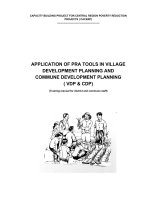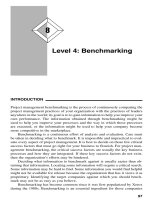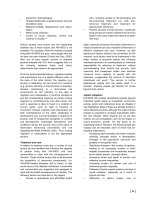W arthur lewis development planning routledge library editions economics, 5 2003
Bạn đang xem bản rút gọn của tài liệu. Xem và tải ngay bản đầy đủ của tài liệu tại đây (1.36 MB, 288 trang )
Routledge Library Editions
DEVELOPMENT PLANNING
ECONOMICS
Routledge Library Editions—Economics
DEVELOPMENT ECONOMICS
In 7 Volumes
I
Western Enterprise in Far Eastern Economic
Development
II
Western Enterprise in Indonesia and Malaya
III Economic
Analysis
and
Policy
in
Underdeveloped Countries
IV The Conditions of Agricultural Growth
V
Development Planning
VI Overhead Costs
VII The Theory of Economic Growth
Allen
Allen
Bauer
Boserup
Lewis
Lewis
Lewis
DEVELOPMENT
PLANNING
The Essentials of Economic
Policy
W ARTHUR LEWIS
LONDON AND NEW YORK
First published in 1966
Routledge is an imprint of the Taylor & Francis Group
This edition published in the Taylor & Francis e-Library, 2005.
“To purchase your own copy of this or any of Taylor & Francis or
Routledge’s collection of thousands of eBooks please go to
www.eBookstore.tandf.co.uk.”
© 1966 George Allen & Unwin (Publishers) Ltd
All rights reserved. No part of this book may be reprinted or reproduced
or utilized in any form or by any electronic, mechanical, or other means,
now known or hereafter invented, including photocopying and
recording, or in any information storage or retrieval system, without
permission in writing from the publishers.
The publishers have made every effort to contact authors/copyright
holders of the works reprinted in Routledge Library Editions—Economics.
This has not been possible in every case, however, and we would
welcome correspondence from those individuals/companies we have
been unable to trace.
These reprints are taken from original copies of each book. In many
cases the condition of these originals is not perfect. The publisher has
gone to great lengths to ensure the quality of these reprints, but wishes
to point out that certain characteristics of the original copies will, of
necessity, be apparent in reprints thereof.
British Library Cataloguing in Publication Data
A CIP catalogue record for this book
is available from the British Library
ISBN 0-203-00929-0 Master e-book ISBN
Development Planning
ISBN 0-415-31299-X (Print Edition)
Miniset: Development Economics
Series: Routledge Library Editions—Economics
W.ARTHUR LEWIS
Development Planning
THE ESSENTIALS OF ECONOMIC POLICY
London
GEORGE ALLEN & UNWIN
Boston
Sydney
First published in 1966
Second impression 1967
Third impression 1968
Fourth impression 1970
Fifth impression 1972
Sixth impression 1976
Seventh impression 1979
This book is copyright under the Berne Convention. All rights
are reserved. Apart from any fair dealing for the purpose of
private study, research, criticism or review, as permitted under
the Copyright Act, 1956, no part of this publication may be
reproduced, stored in a retrieval system, or transmitted, in any
form or by any means, electronic, electrical, chemical,
mechanical, optical, photocopying, recording or otherwise,
without the prior permission of the copyright owner. Enquiries
should be sent to the publishers at the undermentioned address:
GEORGE ALLEN & UNWIN LTD
40 Museum Street, London WClA lLU
© George Allen & Unwin (Publishers) Ltd, 1966
ISBN 0 04 330049 9
Printed in Great Britain by
Biddles Ltd, Guildford, Surrey
PREFACE
Many books have been published on the theory of economic
development, but very little has appeared on how a
Development Plan is made, what the chief snags are, and what
distinguishes good planning from bad. Academic journals have
carried a few esoteric articles on some parts of the subject, but the
man in the street, whose life is affected by those Plans, needs a
short and simple introduction which can help him.
I have written for the intelligent layman, presupposing the
equivalent of one year’s courses in Economics. About a third of
the book is given over to an arithmetical exercise, which explains
the statistical framework of a Plan. This is set out in some detail,
so that students can work it out for themselves with pencil and
paper, if they so desire. In order to show how errors of judgment
reveal themselves, I sometimes do the same thing more than
once, with different policy assumptions.
In making a Plan, technique is subsidiary to policy. Hence,
although the basic techniques are displayed, the emphasis is
throughout on policy. The Economics of development is not very
complicated; the secret of successful planning lies more in
sensible politics and good public administration.
This book does not overlap with my earlier book, The Theory of
Economic Growth, published in 1955, partly because the first book
is philosophical while the second is operational, but mainly
because I had not yet had experience of most of the problems
discussed in the second book while I was writing the first. In
order to be comprehensive the second book would need the
extensive discussion of economic institutions and their
improvement which appears in the first, but I have resisted the
temptation to repeat myself, since most readers of this book will
also have access to the earlier one.
viii
Professors W.J.Baumol, Hollis B.Chenery and F.C.Shorter read
an earlier version of this book, and gave me wise advice; they
have not seen the present version, and are not responsible for it. I
am grateful to successive Secretaries, Mrs Pamela Phipps and
Mrs Dorothy Rieger, for arduous but elegant preparation of the
manuscript.
W.A.L.
Princeton June 1965
CONTENTS
PREFACE
I.
PATTERNS OF PLANNING
vii
1
II.
PLAN STRATEGY
13
1.
Interdependence
14
2.
Foreign Trade
27
3.
Capital Intensity
44
4.
Regional Balance
58
5.
Unemployment
65
6.
The Distribution of Income
77
7.
Public Expenditure
87
8.
Taxes and Savings
106
9.
Inflation
121
10.
Foreign Aid
129
III.
THE ARITHMETIC OF PLANNING
139
1.
The Plan Period
140
2.
The Rate of Growth
142
3.
Projecting Financial Resources
157
4.
Overall Commodity Balance
168
5.
Industrial Balances
175
6.
Linear Programming
188
7.
The Capital Budget
204
x
8.
The Manpower Budget
216
9.
The Government Budget
229
10.
Retrospect
236
IV.
THE PLANNING PROCESS
239
1.
The Planning Agency
239
2.
Planning Committees
241
3.
Federal Planning
247
4.
Preparing Projects
249
5.
The Annual Plan
254
6.
The Private Sector
261
INDEX
271
TABLES
I.
II.
III.
IV.
V.
VI.
VII.
VIII.
IX.
X.
XI.
XII.
XIII.
XIV.
XV.
XVI.
XVII.
XVIII.
XIX.
XX.
XXI.
XXII.
XXIII.
XXIV.
XXV.
XXVI.
XXVII.
XXVIII.
XXIX.
XXX.
XXXI.
XXXII.
XXXIII.
Required School Enrolments
Growth Rate Averages
Projected Sectoral Growth, I
Resources and Their Use, I
Capital Account, I
Government Current Account, I
Projected Sectoral Growth, II
Government Current Account, II
Capital Account, II
Balance of Payments
Resources and Their Use, II
Personal Income
Availability of Commodities
Personal Consumption of Commodities
Input-Output, Year 0
Domestic Final Demand, Year 10
Tentative Final Demand, Year 10
Input-Output Equations
Solution of the Input-Output Equations
Tentative Output, Year 10
Input Coefficients, Year 10
Input-Output, Year 10
Proposed Outputs
Primary Inputs, Totals
Adjusted Final Demand
Programming Model, Stage I
Programming Model, Stage II
Programmed Final Demand, I
Programmed Final Demand, II
Dual Factor Prices
Programmed Final Demand, III
Revised Input-Output, Year 10
Capital Required and Available
97
146
160
162
163
163
164
165
166
166
167
167
171
173
177
178
181
182
182
183
184
186
190
192
194
195
197
198
199
200
201
203
206
xii
XXXIV.
XXXV.
XXXVI.
XXXVII.
XXXVIII.
XXXIX.
XL.
XLI.
XLII.
XLIII.
XLIV.
XLV.
Capital Required for Commodities
Ten-Year Capital Budget
Flow of Funds
Regional Distribution, Year 0
Regional Distribution, Year 10
Capital Budget, by Regions
Sources of Savings, by Regions
Output, Productivity and Population
Educational Requirements, by Industry
Percentage of Secondary and Higher Graduates
Secondary and Higher Graduates Required
Consolidated Budgets
207
208
211
212
214
214
215
216
221
222
224
234
CHAPTER I
Patterns of Planning
Since the end of Second World War most countries of Asia,
Africa and Latin America have published one or more
‘Development Plans’. These Plans differ so much in structure and
content that the title ‘Development Plan’ no longer conveys a
meaning. The first task is therefore to sort out the characteristics
of development planning.
A Development Plan may contain any or all of the following
parts:
(i)
(ii)
(iii)
(iv)
(v)
a survey of current economic conditions;
a list of proposed public expenditures;
a discussion of likely developments in the private sector;
a macroeconomic projection of the economy.
a review of government policies.
Economic Survey
The Plan normally begins by reviewing progress in recent years,
especially since the last Plan was issued. Changes are noted in
population, national output, investment, saving, consumption,
Government expenditure, taxation, the balance of payments, and
the performance of each of the major industries. Giving this
information is not one of the purposes of the Plan; many
governments produce some kind of Annual Economic Survey
with this material, and many also produce Plan Evaluations from
time to time, which examine the progress of the economy in
various spheres, in the light of proposals in the Plan. In the
Development Plan document such information is merely a
curtain raiser, suggesting the problems which must be selected
for further attention.
2 DEVELOPMENT PLANNING
Government Expenditure
When the first Development Plans were issued at the end of the
war, the emphasis was on determining priorities in the public
sector. A review of public expenditure is still an essential part of
any Plan. The first move in preparing a Plan is normally to ask
each Government department or agency to submit its proposals
for expenditure over the period of the Plan. Most of the routine
work on the Plan consists of costing each proposal as carefully as
possible, and estimating potential benefits, financial and
otherwise. The total of the sums requested always greatly
exceeds the money the Government is likely to have; hence the
prime object of this part of the Plan is to assign priorities,
deciding what is to be included, and what shall be postponed or
rejected.
Hardly anybody doubts the value of this kind of periodic
reassessment of what Government departments are planning to
do, even though it is realized that modifications have to be made
in between Plans. It is very easy for Government agencies, like
any other institutions, to drift from day to day. The periodic call
to look ahead, and to make and defend proposals before the
planning authorities, in competition with the proposals of other
agencies, helps departments to keep their sense of direction.
Private Sector Targets
The passage from planning the public sector to reviewing the
private sector was made at an early stage. It was inevitable,
partly because these sectors are inter-related, but still more
because the rate of economic development depends more on
what happens in the private sector than it does on expenditures
in the public sector.
Most Development Plans contain chapters reviewing each of
the major industries, analysing their prospects and their
difficulties, and formulating programmes for increased output or
sales. Special attention is given to promoting new industries
which are thought to have good prospects, having regard to
current estimates of markets and resources. Some of these reviews
include specific targets in quantitative terms (e.g. investment,
employment or output).
PATTERNS OF PLANNING 3
Sometimes these quantitative targets are used for making
policy decisions; more often they are not. A statement that the
output of a particular industry is expected to increase by 45 per
cent during the next five years may have no significance
whatsoever; or may serve merely as propaganda, intended to
encourage producers in that industry to redouble their efforts. If
the figure becomes the basis of policies, such as import controls,
or building licences, or subsidies, it then becomes important to
know how the target of 45 per cent was chosen. Most such
figures are taken out of the air, but some more solid method
becomes essential if the figures are to determine policy.
To prepare a reasonable set of private sector targets for a
Development Plan involves a great deal of work. Markets and
costs must be analysed with the same accounting and statistical
techniques that private firms use for this purpose; and, in
addition, adjustments must be made wherever the gain or loss to
the economy as a whole is thought to be greater or less than that
which accrues to private firms. This must be done for each
industry separately; and then a check has to be made to ensure
that the predictions for each industry are consistent with each
other and with what is predicted for the economy as a whole.
Each industry buys from some other industries at home, and
also buys some imports; it sells to other industries, to consumers
and perhaps to exporters. It generates savings, pays taxes, and
absorbs investment. The sum of the output predicted for each
industry must equal what is predicted for total output; so also
with investment in each industry, consumption of its product,
exports, and so on. The only way to test the consistency of targets
is to make a set of interlocking tables for each industry and for
the economy as a whole. This is done by projecting national
income, using standard national income and input-output
procedures.1
Exercises of this kind have gained rapidly in popularity among
professional planners, mainly because macroeconomic planning
provides a consistent framework for all the quantitative aspects of
the Plan. In extreme cases the shape of the Plan is completely
transformed. We are told in detail how much each industry will
produce, import, export and invest; but there is no list of
Government projects, and no indication of the policies which
might bring the predicted results.
4 DEVELOPMENT PLANNING
This evolution of planning concepts, from listing public
expenditures, through reviewing industrial and agricultural
policies, to making macroeconomic models, has not been
unaccompanied by controversy. For one thing these different
kinds of planning are done by different kinds of persons, each
proud of his own methods, and somewhat contemptuous of the
others’. A plan for public expenditure is best made by a man with
Treasury experience, who is used to dealing with Government
departments, and knows their tricks. A Plan centred on public
policy is best made by a ‘practical’ economist, who knows the
kinds of problems that emerge in developing economies, the
various solutions which have been tried in various places, and
the extent of their failures and successes. A Plan consisting of
interdependent tables needs an econometrician, who can invent
figures when they do not exist, make interdependent models, and
solve any number of simultaneous equations. As these three
types of men have jostled one another, they have snarled at each
other, and made hostile remarks about each others’ work. Here is
an example from an august source: the Report to the President of
the United States from the Committee to Strengthen the Security of the
Free World (known as the Clay Report) on The Scope and
Distribution of United States Military and Economic Assistance
Programmes:
There is a difference between sound national budgeting in
economic and social terms on the one hand and theoretical
long-term national development planning as it is often
encountered. Extrapolations of mathematical models based
on questionable statistics for debatable base periods seem to
have a way of going wrong, even when it is possible to find
economists who agree with each other. Furthermore these
long-term projections have been of little or doubtful value
and frequently have proved harmful by directing attention
to the theory of economic development at the expense of its
practical implementation. Sound governmental planning
consists of establishing intelligent priorities for the public
investment programme and formulating a sensible and
1
See Chapter III, section 5 below.
PATTERNS OF PLANNING 5
consistent set of public policies to encourage growth in the
private sector (p. 16).
Macroeconomic Planning
The principal danger of a macroeconomic exercise lies in its
propensity to dazzle. The more figures there are in a Plan,
produced by an army of professionals who have laboured
mightily to make them consistent, the more persuasive the Plan
becomes. Attention shifts from policy to arithmetic. Consistency
can be mistaken for truth. Revision is resisted. Yet the Plan is not
necessarily right merely because its figures are mutually
consistent. However, this is a psychological rather than an
intellectual danger. Once the point is grasped that mathematical
exercises do not of themselves produce truth, a Plan with figures
is no more dangerous than a Plan without figures.
The question remains: what useful purpose is served by
producing doubtful target figures for the private sector? The
answer turns on a number of factors, especially on the degree of
interrelationship between private and public sectors, on the
amount of control exercised over the private sector, on the
persuasiveness of the planning process, and on the availability of
reliable statistics.
That the public and private sectors are interrelated cannot be
doubted, but it does not follow that one must make a
mathematical model of the whole economy. Each public agency
must take account of private plans when making its own. The
Electricity Department must consult all potential major uses of
power, in order to forecast demand. The Water Department must
try to find out where new industries are to be located. Transport
and other communications must also be integrated with the
private sector, and so on, all along the line. This calls for much
consultation with the private sector, but to include the results of
this consultation in the plans of the public sector is relatively
simple. Large-scale investors in the private sector have to meet
the same problem every day; they have to know, or guess, how
others will behave, in both the private and the public sectors. In
small countries where all the chief decision makers know each
other, and consultation is easily arranged, co-ordination can be
achieved without elaborate models. In larger countries, like
6 DEVELOPMENT PLANNING
Britain or France or the United States, this argument for models
is much stronger.
Public and private sectors are also interrelated in that the total
size of the public sector programme must depend on what the
private economy can bear. Most public sector programmes are
too large. Typically a new Government comes into office having
promised everybody schools, hospitals, water supplies,
electricity, roads, houses, jobs and all the other good things of life.
Undaunted by finding that the Treasury is empty, and that taxes
bring in only 9 per cent of the national income, it proceeds
to make a Plan. Postulate that the national income, now rising by
3 per cent, will rise by 7 per cent per annum through the Plan
period, and you can programme on the basis that public revenue
may be as much as 50 per cent larger within five years. The
postulate is absurd, but that may not be obvious. Ask the
planners to produce a programme for the economy as a whole,
showing how all the various sectors are to expand, and this type
of absurdity then becomes less plausible. But this is like using a
steam hammer to crack a nut. One does not have to make elaborate
models of the whole economy to come out with a reasonable
basis for estimating what the public revenue will be.
The second argument for comprehensive planning turns on the
degree of control which the Government exercises over the
private sector. If the Government controls the private sector,
through licenses, quotas and price-fixing, or attempts to influence
the private sector through subsidies, it needs a well-articulated
model to ensure that its decisions are both efficient and mutually
consistent. A controlled private sector is like the public sector in
that, if sensible decisions are to be made, they should be made in
accordance with some programme. Now there is no doubt that
the market economy, left to itself, gives the wrong answers in
underdeveloped countries. Prices do not correctly reflect relative
costs. Opportunities for reducing risks through co-ordinated
action are neglected. Insufficient allowance is made for the value
of knowledge acquired through unprofitable activities, and so
on. The temptation to control the private sector, or at least to
induce businessmen to do what they would not otherwise do, is
therefore almost irresistible. Of course, an equally impressive
case can be made against Government control of business; the
Government is inefficient, corrupt, wasteful, not impartial, and so
on. However, Government controls or influences business
PATTERNS OF PLANNING 7
behaviour to some extent in every country in the world. We note
merely that if the Government exercises extensive control over
the private sector, it will need a programme for the private sector
to ensure that its decisions are efficient and mutually consistent.
The Government may not require to forecast the prospective
behaviour of the whole economy for its own decision-making;
yet such a forecast may be useful in other ways. For there is a
third argument in favour of such predictions, namely that the
result may persuade private individuals to act more
adventurously than they otherwise would. This argument turns
on the interdependence of investment decisions. Suppose Firm A
contemplates building a refrigerated storeroom. Its success may
depend on whether Firm B goes ahead with its fishing trawlers,
whether Firm C will bring down cattle from the North for
slaughter, whether Firms D and E carry out their plans for
employing 1,000 men, who will eat meat and fish stored in
refrigerated space, and so on. For any one of these firms to go
ahead it is necessary first to estimate what demand and supply
will be if the others also go ahead, and secondly to be given some
assurance that there will be a general forward movement.
Forecasts for the whole economy help all concerned to see the
possibilities created by a general expansion. The forecast cannot
always provide full assurance of a general movement, but if it is
constructed co-operatively, with private and public decision
makers consulted at all crucial stages, the very planning process
may help to give investors confidence. When a macroeconomic
forecast is made for this purpose, it is known as ‘indicative
planning’.
Indicative planning presupposes that the economy responds
mainly to domestic demand, as is the case in mature economies.
In very poor economies exports are most usually the engine of
growth, and development depends mainly on opening up new
export possibilities, or making better use of existing possibilities.
The planners can therefore take the market for granted, and
concentrate on opening up new natural resources for
development, or improving the utilization of existing resources.
An interrelated model begins to be useful as the economy begins
to exploit the opportunities for import substitution, and to
develop a complex pattern of inter-industrial relationships. The
greater the interrelationships the more necessary it becomes to
have an input-output model to reveal results which are no longer
8 DEVELOPMENT PLANNING
obvious. But in the average small, underdeveloped economy,
input-output manipulations are not likely to tell the planners
much that they do not already know.
The distinction between an ‘indicative’ and a ‘controlling’ Plan
is important The Plans made by Communist countries are
documents of authorization; they tell each industrial unit what it
must produce and how much it may invest. A Development Plan,
on the other hand, authorizes nothing. Even public expenditure
is authorized not by the Plan but only by the Annual Budget
passed by Parliament. The figures in a Development Plan
indicate expectations, aspirations and intentions, but are not
binding commitments. This (as we shall see later) is one reason
for the irresponsible tendency to use grossly inflated figures,
intended to impress the reader, without committing the writer. On
the other hand, the fact that the indicative Plan does not commit
helps it to ride changing circumstances better than a document
which seeks to effect control.
Finally, the value of a macroeconomic exercise depends on how
much confidence one has in the figures. Even in countries which
are rich in statistics, forecasts of the economy have usually turned
out poorly. In poor countries the econometrician has to invent
many of the crucial figures. He says: ‘The income elasticity of
demand for food has not been measured; let us assume it to be 0.
8.’ Or: ‘We do not know what the ore content will turn out to be;
let us assume it to be 48 per cent.’ Or: ‘It seems reasonable to
assume a marginal savings ratio of 0.2.’ Unfortunately, even if
each of the basic assumptions were right to within 1 per cent, the
final results could be highly erroneous, because so many crucial
magnitudes are found by difference. For example, if we subtract
10,000 from 10,300, the answer is 300. But if we are told that each
of the basic figures may be 1 per cent out, we can only be sure
that the answer lies between 97 and 503, which is a range of 500
per cent! Many important magnitudes in economics are found by
subtractions involving two nearly equal quantities; the balance of
trade is the difference between imports and exports; personal
saving is the difference between disposable income and
consumption; the budget surplus is the difference between
revenues and expenditures. Relatively small errors are therefore
easily magnified.
The conclusion must be that it is useful to undertake statistical
exercises where we have plenty of fairly reliable statistics; but the
PATTERNS OF PLANNING 9
same exercises would be pointless where we would have to
invent most of the statistics. It is useful to go through these
exercises where we have plenty of statistics, even though we
know that statistics are never completely reliable. For one thing,
statistics can serve as cross-checks for each other, so reliability
increases in something like geometrical proportion to the number
of available figures. Furthermore, the larger and more complex
the economy, the less easy it is to keep the whole thing in one’s
head, and make interrelated decisions without calculation. In
poor economies the statistics may easily mislead. One frequently
rejects the statistics one is offered because one believes them to be
wrong, having regard to what one knows about other economies
at a similar level of development. (For example, we have had
plenty of wild estimates of population growth, national income
per head, numbers engaged in agriculture, growth of
productivity, etc.) A sensible person, familiar with the economy,
can often give a more correct quantitative answer than one would
get from the available statistics. Also, since the economy is fairly
simple, its interrelations are fairly obvious, and one can reach
good conclusions without elaborate models.
In a country with poor statistics, the first Development Plan,
and even the second, should concentrate on bringing order into
the public sector’s programmes, and into economic policy. This is
largely a matter of improving administrative machinery. The
Cabinet has to learn not to take an important economic decision
until civil servants and technical advisers have examined the
matter from every angle. Ministries must be staffed with people
competent to analyze the policies which they administer, and to
prepare or have prepared, good feasibility studies of proposed
projects. Experience must be acquired in planning a project,
getting it started, keeping it on schedule, amending it to take
account of unforeseen snags, and evaluating its results from time
to time. Without a reasonably competent administrative
machine, there is no basis for development planning.
Meanwhile, collection of useful statistics should also be
accelerated. Then by the time one makes the Third Development
Plan, there may be enough reliable statistics to justify attempting
to construct an interdependent model for the whole economy.
Much depends on the country’s size, and on the degree of
interrelationship between its industries, since one can carry in
one’s head the interrelationships of a small simple economy, but
10 DEVELOPMENT PLANNING
not of a large or complex country. Whether the economy responds
mainly to export demands, or grows mainly in response to home
demand, is also important. India is certainly ready for an
elaborate mathematical model; whereas in most of the simpler
African economies such a model would do no good, and, as the
Clay Committee suggests, might well do harm, by deflecting
attention from the major task of evolving useful policies and
institutions.
Policy
In the private sector statistics may help, but what really counts is
policy. The Government is seeking to induce people to do what
they would otherwise not do—invest more in physical resources
or in their own skills; change their jobs; switch from one crop to
another; adopt new technologies; and so on. The set of policies
which it will adopt to bring about these results is the core of
private sector planning.
Can a Government really contribute to raising the rate of
growth in the private sector of the economy? The first task of a
Development Plan is to bring order, priority and foresight into
Government expenditure; any Plan which achieves this is already
making a substantial contribution. Can a Government usefully do
more? The answer is in the affirmative. The main elements of
development policy may be listed as follows:
1. Investigation of development potential: surveys of natural
resources; scientific research; market research.
2 . Provision of adequate infrastructure (water, power, transport
and communications) whether by public or private agencies.
3 . Provision of specialized training facilities, as well as
adequate general education, thereby ensuring necessary
skills.
4. Improving the legal framework of economic activity,
especially laws relating to land tenure, corporations, and
commercial transactions.
5. Helping to create more and better markets, including
commodity markets, security exchanges, banking, insurance
and credit facilities.
6. Seeking out and assisting potential entrepreneurs, domestic
and foreign.
PATTERNS OF PLANNING 11
7.Promoting better utilization of resources, both by offering
inducements and by operating controls against misuse.
8.Promoting an increase in saving, both private and public.
The quality of a Development Plan should be tested mainly by
examining what is proposed under each of these heads. The
recent trend towards putting more figures into Development
Plans has unfortunately tended to obscure the fact that what
matters in planning is not mainly figures but mainly policy. It is
possible to write a good Development Plan without using any
figures, by concentrating on policies which will stimulate an
upward move ment of the economy. It is also possible to write a
Development Plan which is mathematically completely
consistent, but which will nevertheless achieve nothing, because
policies are lacking.
Success is hard to measure. If private enterprise moves ahead
vigorously, the critics of planning are likely to say that the Plan
made no difference; that private entrepreneurs would have acted
even if there had been no Plan. Even if growth is slow, it might
have been slower but for the Government’s effort, but this is not
easily proved.
Neither can success be guaranteed, even by the best policies. We
do not really know why some countries are more dynamic than
others. Some countries experience phases of great activity in
literature, painting, music, war or religion; and dynamism in
economic affairs may spring from the same deep and uncharted
sources. It is probably no easier or more difficult to plan an
artistic renaissance than to plan economic development. Good
policies help, but do not ensure success. Development planning
is in this respect like medicine; the good practitioner knows some
useful tricks; but it is still the case that many patients die who are
expected to live, and many live who are expected to die.
Summary
1. A Development Plan may contain any or all of the following
features: (i) a survey of the current economic situation; (ii)
proposals for improving the institutional framework of economic
activity; (iii) a list of proposed Government expenditures; (iv) a
review of major industries; (v) a set of targets for the private
sector; (vi) a macroeconomic projection for the whole economy.
12 DEVELOPMENT PLANNING
2. The macroeconomic projection is useful for testing the
mutual consistency of the quantitative assumptions and
proposals in the Plan; and may also stimulate investment by
revealing unsuspected relationships. Its usefulness depends on
the quality of the statistics which go into it. Given adequate
statistics, it is useful in large, complex economies; not useful in
small, simple economies. The danger of the exercise lies in the
possibility of being dazzled by an array of doubtful figures.
3. The core of planning for higher productivity in the private
sector lies in a set of policies which induce private persons to
employ their time and resources more productively. The
quality of a Plan depends on the quality of its policies, rather
than on the quality or quantity of its arithmetic.
FOR FURTHER READING: GENERAL WORKS
Hagen, E.E. (Editor). Planning Economic Development. Homewood, 111.,
1960.
Hirschman, A.O. The Strategy of Economic Development. New Haven, 1958.
Lewis, J.P. Quiet Crisis in India. Washington, D.C., 1962.
Tinbergen, J. The Design of Development. Baltimore, 1958.
United Nations. Planning for Economic Development. New York, 1963.









